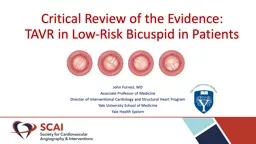

TAVR in LowRisk Bicuspid in Patients John Forrest MD Associate Professor of Medicine Director of Interventional Cardiology and Structural Heart Program Yale University School of Medicine Yale Health System ID: 912530
Download Presentation The PPT/PDF document "Critical Review of the Evidence:" is the property of its rightful owner. Permission is granted to download and print the materials on this web site for personal, non-commercial use only, and to display it on your personal computer provided you do not modify the materials and that you retain all copyright notices contained in the materials. By downloading content from our website, you accept the terms of this agreement.
Slide1
Critical Review of the Evidence: TAVR in Low-Risk Bicuspid in Patients
John Forrest, MDAssociate Professor of MedicineDirector of Interventional Cardiology and Structural Heart ProgramYale University School of MedicineYale Health System
Slide2Disclosures
I serves as a consultant and physician proctor for: Edwards Lifesciences, and Medtronic Inc.
The Yale Structural Heart Disease Fellowship Program receives grants from Edwards and Medtronic.
Slide3Background
TAVR has demonstrated excellent outcomes in tricuspid aortic stenosis and is currently approved for patients across all risk classes.
Patients with bicuspid aortic stenosis have been excluded from major TAVR trials.
Recent retrospective reports from the TVT Registry have suggested that outcomes of TAVR in intermediate-high risk patients with bicuspid valve disease are similar to that for tricuspid patients.
Prior to Low Risk Bicuspid Trial, there have been no prospective studies assessing TAVR in low risk patients with bicuspid aortic stenosis.
Slide4The Low Risk Bicuspid Trial
*To assess the procedural and short term (30-day) outcomes of TAVR in low risk patients with bicuspid aortic valve stenosis.Objective
*Presented at ACC.20 by Dr. Ramlawi
Slide5Multicenter, prospective, single-arm study at 25 centers also participating in Evolut Low Risk Trial
Baseline CTA to confirm bicuspid morphology and anatomic suitability
Patient eligibility reviewed by local Heart Team & Screening Committee
Implant Procedure
Annular sizing for all patients
Pre-TAVR balloon valvuloplasty strongly encouragedCEC adjudicated all endpoint-related adverse eventsHemodynamics centrally assessed by echocardiographic core laboratory Patient follow-up planned for 10 years
Study Methods
Slide6Inclusion/exclusion criteria and screening process based on Evolut Low Risk TrialSymptomatic and asymptomatic severe AS1
A predicted risk of 30-day mortality <3% per multidisciplinary local Heart Team assessmentBicuspid aortic valve anatomy confirmed by CTAKey Inclusion Criteria
1Nishimura RA, et al. Circulation. 2014;129:2440-92
Slide7Age < 60 years*Ascending aorta diameter > 4.5 cm*Trileaflet aortic valve on CTA*
Multivessel coronary artery disease (SYNTAX score >22)Prohibitive LVOT calcificationAnatomic dimensions outside recommended rangeSOV AnnulusKey Exclusion Criteria
* Criteria that differ from Evolut Low Risk Study
Slide8Primary Safety Endpoint
All-cause mortality or disabling stroke at 30 daysStudy Endpoints
Primary Efficacy Endpoint
Device Success
Absence of procedural mortality ANDCorrect position of 1 valve in the proper anatomical location AND
Absence of > mild aortic valve regurgitation
Slide9Patient Flow
Patients consented (n=222)
Excluded (n=72):
Exclusion criteria met (n=60)
Patient withdrawal (n=2)
Physician withdrawal (n=3)
Other (n=7)
Attempted procedure (n=150)
Aborted procedure (n=1)
Implanted TAV (n=149)
30-Day follow-up (n=147)
Death (n=1)
Discharged with TAV (n=148)
Conversion to surgery (n=1)
Slide10N = 60
Anatomical reasons
46
Tricuspid aortic valve
17
Aortic annulus size (perimeter)
15
Mean ascending aorta > 45 mm
9
Aortic root dimensions: SOV diameter
4
Prohibitive LVOT calcification
1
Risk of mortality outside protocol (> low risk)
5
Contraindication for placement of bioprosthetic valve
3
Allergies
2
Did not meet severe AS criteria
2
Age less than 60 years
1
Other condition excluding from study per investigator
1
Reasons for Study Exclusion
Slide11Mean ± SD or no.
(%)N = 150
Age, years
70.3 ± 5.5
Male sex
78 (52.0)
STS PROM, %
1.4 ± 0.6
NYHA Class III or IV
41 (27.3)
Peripheral arterial disease
14 (9.3)
Chronic lung disease/ COPD
26 (17.7)
Prior coronary artery bypass grafting
2 (1.3)
Mean gradient, mm Hg
48.0 ± 16.1
Aortic valve area, cm
2
0.8 ± 0.2
Baseline Clinical Characteristics
Slide12Bicuspid Valve Sievers Subtypes
Type 0N = 14
Type ILeft-RightN = 107
Type IRight-NonN=27
Type I Non-LeftN= 2
No patients had Sievers Type 2
9.3%
71.3%
18.0%
1.3%
Slide13No. (%)
N = 150
General anesthesia
95 (63.3)
Iliofemoral access
147 (98.7)
Embolic protection
45 (30.0)
Pre-TAVR balloon dilation
137 (91.3)
Post-TAVR balloon dilation
55 (36.9)
> 1 valve implanted
5 (3.3)
Procedural Characteristics
No. (%)
N = 150
Valve Repositioned
49 (32.9)
Implanted valve size
23 mm
0 (0.0)
26 mm
32 (21.5)
29 mm
55 (36.9)
34 mm
62 (41.6)
Slide14Evolut
R Valve [43%]
Evolut
PRO Valve [57%]
23, 26, 29 and 34 mm
23, 26 and 29 mm
Valves Used
Slide15No. of patients (KM estimates as %)
N = 150
All-cause
mortality or disabling stroke
2 (1.3)
All-cause mortality
1 (0.7)
Disabling stroke
1 (0.7)
Non-disabling stroke
5 (3.3)
Major vascular complication
2 (1.3)
Aortic dissection
0 (0.0)
Annular rupture
0 (0.0)
New Permanent pacemaker†
22 (15.1)
Coronary artery obstruction
1 (0.7)
Outcomes at 30 Days
†Excludes patients with baseline permanent pacemaker
.
Slide16No. of patients (%)
Device success
141/148 (95.3)
Patient-prosthesis mismatch
None
115 (87.1)
Moderate
10 (7.6)
Severe
7 (5.3)
Mean gradient > 20 mm Hg
2/146 (1.4)
Additional Outcomes at 30 Days
Slide17Valve Hemodynamics
Slide18Valve Hemodynamics by Subtypes
Type 0
Type 1
18
Slide19Total Aortic Valve Regurgitation at 30 Days
Implant population. Core lab assessments.
Slide20TAVR with the Evolut valve in low-risk bicuspid patients achieved favorable procedural and short term (30-day) results:95.3% device success
Low mortality and stroke at 30 days (1.3%)Low rates of PVL (no moderate/severe)Consistent hemodynamics across Sievers ClassificationPatients will be followed for 10 yearsSummary
Slide21Non-randomized study designProcedural and short-term outcomes (30 day)Study performed at high volume experienced centers who were also participating in Evolut Low Risk Randomized Study
Limitations
Slide22In this prospective study, procedural and 30-day results demonstrated that TAVR with the Evolut Valve was safe and effective in low risk patients with bicuspid aortic stenosis.
Longer-term outcomes are needed, and carefully constructed randomized controlled trials comparing TAVR to surgery in this patient population should be considered prior to any changes in clinical guidelines.Clinical Implications
THANK
YOU